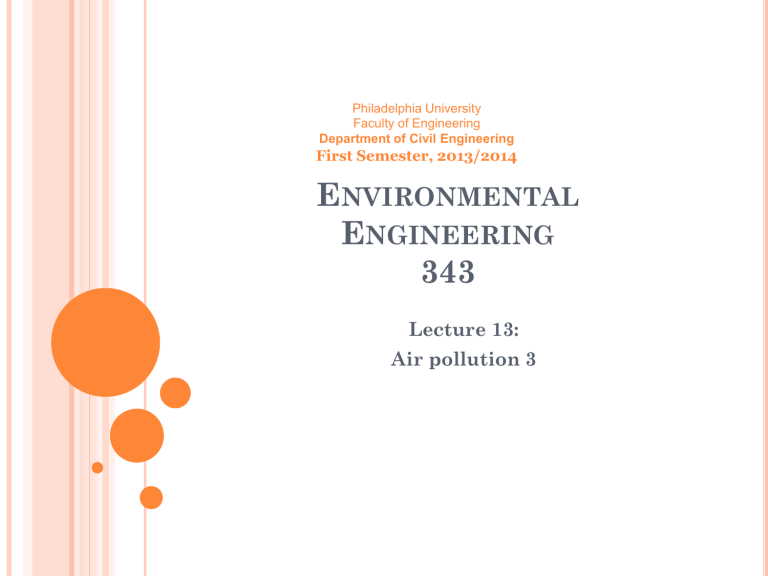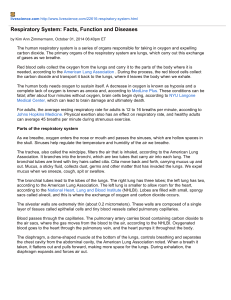E 343 NVIRONMENTAL NGINEERING
advertisement

Philadelphia University Faculty of Engineering Department of Civil Engineering First Semester, 2013/2014 ENVIRONMENTAL ENGINEERING 343 Lecture 13: Air pollution 3 AIR POLLUTION EFFECTS : HUMAN HEALTH EFFECTS Exposure to air pollution is associated with numerous effects on human health, including pulmonary, cardiac, vascular, and neurological impairments. The health effects vary greatly from person to person. High-risk groups such as the elderly, infants, pregnant women, and sufferers from chronic heart and lung diseases are more susceptible to air pollution. Children are at greater risk because they are generally more active outdoors and their lungs are still developing. Exposure to air pollution can cause both acute (short-term) and chronic (longterm) health effects. Acute effects are usually immediate and often reversible when exposure to the pollutant ends. Some acute health effects include eye irritation, headaches, and nausea. Chronic effects are usually not immediate and tend not to be reversible when exposure to the pollutant ends. - Some chronic health effects include decreased lung capacity and lung cancer resulting from long-term exposure to toxic air pollutants. EFFECTS ON HUMAN RESPIRATORY SYSTEM Both gaseous and particulate air pollutants can have negative effects on the lungs. Solid particles can settle on the walls of the trachea, bronchi, and bronchioles. Continuous breathing of polluted air can slow the normal cleansing action of the lungs and result in more particles reaching the lower portions of the lung. Damage to the lungs from air pollution can inhibit this process and contribute to the occurrence of respiratory diseases such as bronchitis, emphysema, and cancer. SOURCES, HEALTH AND WELFARE EFFECTS FOR CRITERIA Pollutant Description Sources Health Effects Carbon Colorless, odorless gas Motor vehicle exhaust, indoor Headaches, reduced mental Monoxide (CO) sources include kerosene or wood alertness, heart attack, burning stoves. cardiovascular diseases, impaired fetal development, death. Sulfur Dioxide Colorless gas that Coal-fired power plants, Eye irritation, wheezing, (SO2) dissolves in water petroleum refineries, chest tightness, shortness of vapor to form acid, and manufacture of sulfuric acid and breath, lung damage. interact with other smelting of ores containing gases and particles in sulfur. the air. Nitrogen Reddish brown, highly Motor vehicles, electric utilities, Susceptibility to respiratory Dioxide (NO2) reactive gas. and other industrial, commercial, infections, irritation of the and residential sources that burn lung and respiratory fuels. symptoms (e.g., cough, chest pain, difficulty breathing). Welfare Effects Contribute to the formation of smog. Ozone (O3) Gaseous pollutant Vehicle exhaust and certain when it is formed in the other fumes. Formed from other troposphere. air pollutants in the presence of sunlight. Plant and ecosystem damage. Lead (Pb) Metallic element Particulate Matter (PM) Very small particles of Diesel engines, power plants, soot, dust, or other industries, windblown dust, matter, including tiny wood stoves. droplets of liquids. Eye and throat irritation, coughing, respiratory tract problems, asthma, lung damage. Contribute to the formation of acid rain, visibility impairment, plant and water damage, aesthetic damage. Contribute to the formation of smog, acid rain, water quality deterioration, global warming, and visibility impairment. Metal refineries, lead smelters, Anemia, high blood pressure, Affects animals and plants, battery manufacturers, iron and brain and kidney damage, affects aquatic ecosystems. steel producers. neurological disorders, cancer, lowered IQ. Eye irritation, asthma, bronchitis, lung damage, cancer, heavy metal poisoning, cardiovascular effects. Visibility impairment, atmospheric deposition, aesthetic damage.






